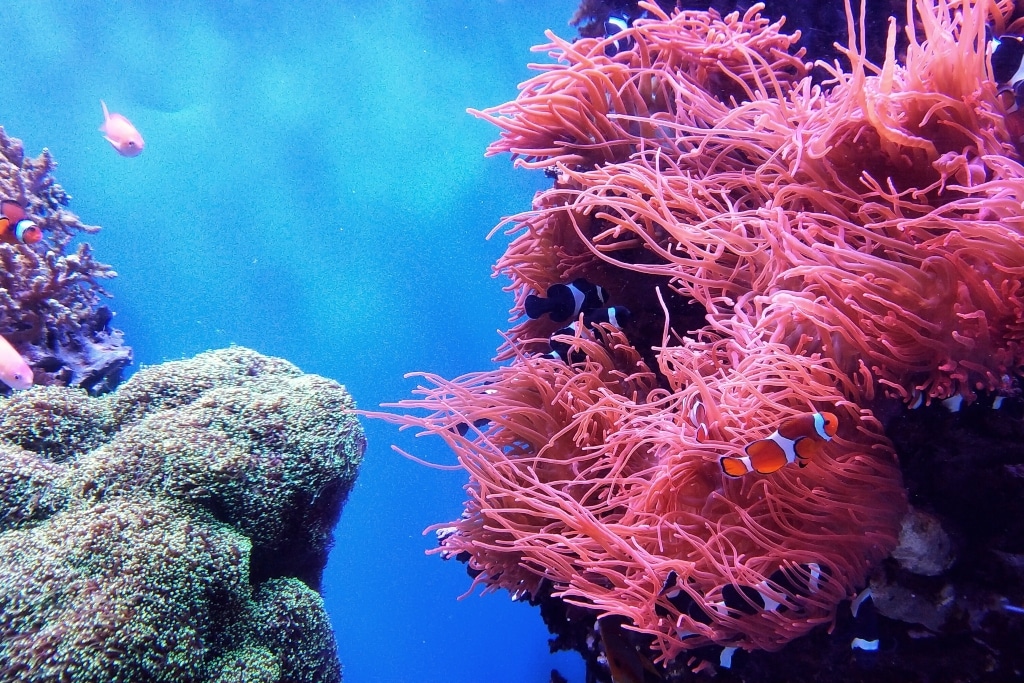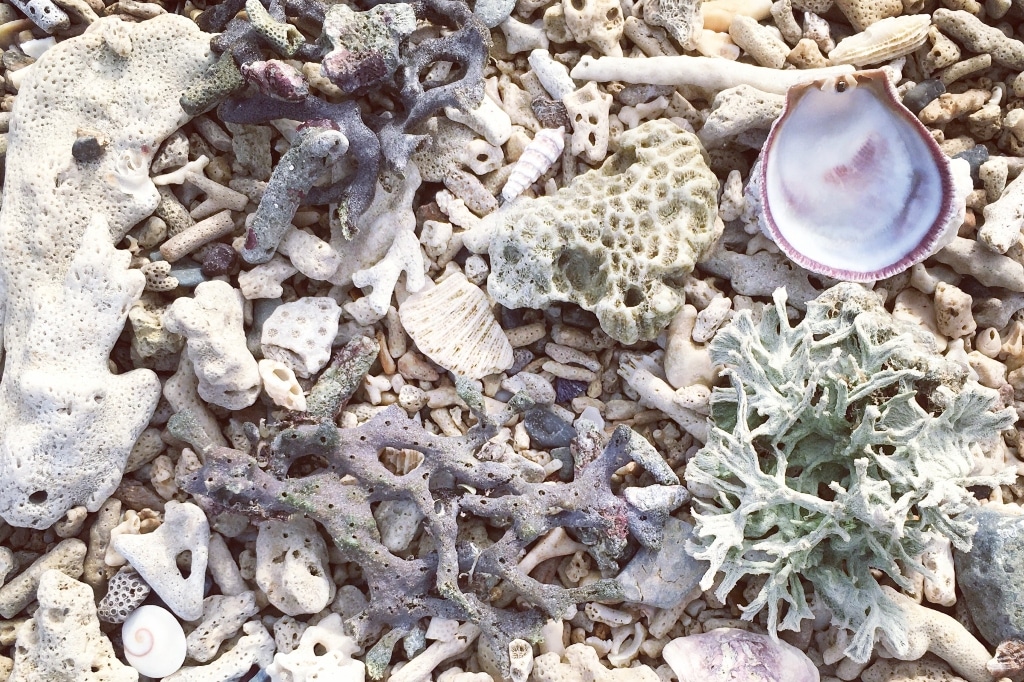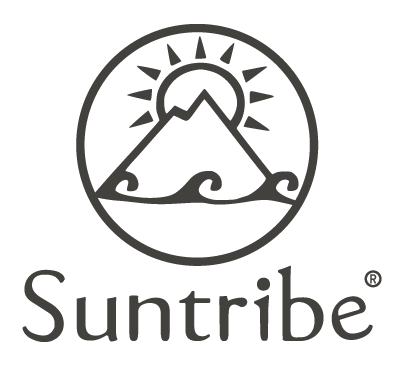Nature, Health & Sunscreens

"All in all, the cosmetics industry is one of the most unregulated industries in the world, and this means that we need to be extra careful in choosing safe ingredients."
- Karl, Suntribe Co-Founder
After decades of research it has now become clear that there are several very real causes for concern when it comes to cosmetics and sunscreen. The problems are complicated. Mostly it’s about the ingredients used, and how they are not properly tested and evaluated before they are approved for use in cosmetics and placed on the market. There are 1000’s of different approved ingredients to use and cosmetics companies do not need to test them, or even stop using them once research finds them to be harmful. All in all, the cosmetics industry is one of the most unregulated industries in the world, and this means that we need to be extra careful.
In this section we want to try and explain the problems in a way that makes sense. First we summarise, then we go in depth. If you are more of a movie person, we recommend watching Toxic Beauty (2019) to learn about these problems. These three points highlight the major problems with cosmetics and sunscreen today
1.
Some are dangerous
Some ingredients are proven straight out dangerous for humans, and harmful for the environment. Let’s take two examples: Recent studies have proven that there is a link between the use of chemical sunscreen during pregnancy and rare diseases in the child (DiNardo & Downs 2019) and the correlation of the use of chemical sunscreen and the bleaching of the coral reefs have long been proven (Danovaro 2008, Wood 2018).
2.
Some are still uncertain
A lot of ingredients used in cosmetics and sunscreen are still not properly evaluated. This simply means that we really do not know if they are safe for use! Two famous examples of ingredient categories that were (and still are) present in a lot of cosmetics, but which now have been proven harmful are phthalates and parabens. Let´s solve the problem of uncertain ingredients by using those that have been proven not to be dangerous instead.
3.
Some are hard to understand
Cosmetics and sunscreen can be very hard to understand, and then it can become dangerous. A common example from the cosmetics industry is the labeling of perfumes and fragrances. These labels can hide some very nasty ingredients and it’s just impossible to know! Whenever a manufacturer chooses to use those generic terms for their ingredients, it’s worth knowing that in several cases they have been found to contain ingredients proven harmful.

Change is on the Way
We think that the real world proof always hits home the hardest. Here are the top examples that we at Suntribe think shows that the world is heading for a change when it comes to sunscreen.
Governmental agencies are starting to react
The FDA and similar agencies are currently re-evaluating their traditional stance on chemical UV-filters. They have now admitted that most of these chemicals can no longer be considered safe, and that we can expect the regulations to change. These studies clearly show that several chemical UV-filters easily get absorbed into the bloodstream, which combined with studies showing the negative effects of the same chemicals, paint a dark picture. This suggests very strongly that there is a real problem with chemical UV-filters used in conventional sunscreen and human health.
Countries are banning conventional sunscreens
Several countries have taken steps to ban a range of chemical UV-filters. This means you will no longer be allowed to bring sunscreens with these ingredients into that entire country or region. This suggests very strongly that there is a real problem with chemical UV-filters and environmental degradation.
Now you have a general idea of the problem – that both human beings and the environment are suffering because of the conventional industries neglect and use of harmful ingredients. Below we take a deeper look at the different areas of the cosmetics and sunscreen industries, and try to show what we think the biggest issues are. Only once you know what the problems are can you avoid them, and start solving them!

The Problem With Cosmetics in General
Cosmetics is one of the most unregulated industries in the world. This means that we basically have to just trust that companies are using safe ingredients. This is a faulty method, and is sure to lead to danger and harm. The big issue is that there are so many different ingredients being used in cosmetics and to scientifically evaluate all of them in realistic, everyday life conditions is a very big challenge.
This is why we oftentimes find out that certain ingredients are harmful only in hindsight. When we do find out that a certain ingredient is harmful it has already been widely available on the market for several years. The way to avoid this general issue in the cosmetics industry is to only use well tested and scientifically verified ingredients that have been on the market and evaluated for a long period of time. The issue with this of course is that it is very cheap and profitable to use inexpensive synthetic chemicals, regardless of their effect on the environment or our health.
According to EWG’s (Environmental Working Group’s) cosmetics mapping, we can find a whole range of hazardous ingredients in everyday common cosmetics. This is not an uncertain field of science – We know that humans do not benefit from being in contact with these ingredients, in fact we know them to be harmful to us.
Below we will detail some of the most well researched and harmful groups of ingredients (click on the ingredient to read more):
Formaldehyde is a known carcinogen which still can be found in several hair treatment, body soap and nail polish products. There is no uncertainty as to whether it is good for us or not; we know it’s bad, we know it can cause cancer, but still it’s used in products intended for human use. Another known carcinogen is coal tar which is also found in several hair dyes and shampoo products. This ingredient has been associated with cancer in the lungs, bladder, kidney and in the digestive tract (Bonner et al. 2005) (U.S. Department of Health and Human Services 2016).
Heavy metal in cosmetics is another cause of concern, and we’re not talking about the music genre.
It’s no secret that metals like lead, arsenic and mercury are harmful to humans, so why then would we add them to cosmetics? Well, some heavy metals are intentionally added as ingredients because they are supposed to fill some specific purpose. However, much of the heavy metals found in cosmetics are contaminants from the production and which end up in the final product unintentionally. To find them in the ingredient list, you need to look out for: Lead acetate, chromium, thimerosal, hydrogenated cottonseed oil, sodium hexametaphosphate.
Research has mapped the occurence of heavy metals in common cosmetics products, and found that indeed some cosmetics have very high concentrations of certain elements. The recommendation from the researchers is that we need to thoroughly test these products on humans before we release them on the market. Unfortunately, they are already on the market. This illustrates the great mismatch between what scientists know, and what regulators allow.
Another important category is endocrine disruptors. These are ingredients which disrupt parts of our body’s hormonal system. The endocrine system is a vital part for human development and disruptions to this system can for example lead to decreased fertility in men, genital malformations in boys, premature birth and low birth weight, autism, ADD and other learning disabilities, endocrine related cancers such as breast, ovarian, prostate, testicular and thyroid, obesity, and type 2 diabetes. Find the endocrine society’s full study here.
This issue is receiving a lot of scientific attention because it is so widespread. Let’s look at where you commonly find these EDC’s (Endocrine Disrupting Chemicals) in cosmetics and what they are called.
1. UV-Filters. Found in most conventional sunscreens. Ingredient examples: oxybenzone, octyl methoxycinnamate, 4-methylbenzylidene camphor
2. Phthalates. Found in cosmetic fragrances, nail polishes and lotions. Often listed as “Fragrance” or “Perfume” in the list of ingredients.
3. Parabens. Found in lots of cosmetics and personal care products. Ingredient examples: propyl-, isopropyl-, butyl- and isobutyl-parabens.
What we know is that regular exposure to EDC’s can have disastrous consequences on anyone, but most specifically on vulnerable people such as young children and pregnant women. The most drastic negative side effects are commonly found in children where the mother was exposed to these chemicals during pregnancy.
As a tool and real world example of this issue, the Danish health authority has created this fantastic brochure about how to avoid EDC’s and similar chemicals during pregnancy.
The last point we want to touch on was a surprising one for us, so much so that we wrote a full blog article about it! Microplastics in cosmetic products is a real problem, both for us humans and for the environment.
In a test, it turned out that a single bottle of the Olaz Anti-Wrinkle Firm & lift SPF 15 Day Cream (50ml) contains about 1.48 million plastic particles. In total humans release about 15 million tons of microplastics into the oceans each year. Roughly 2% of that comes from cosmetics. Researchers have also detected measurable levels of microplastics in fish and seafood that is sold for human consumption (Chae & An 2017, Eriksen et al. 2014).
Although the problem seems small, microplastics in cosmetics contribute to environmental pollution and endanger humans in ways we have not yet fully understood.
Freaking out yet? Don’t worry, use these resources to check up on products and ingredients you are unsure about: safecosmetics.org and EWG.org. And keep reading to learn how to avoid the problem better.

The Issue is Long Term
How can this be? How is it possible that we couldn’t find this out sooner and prevent dangerous products from being available to humans all over the globe?
The largest reason is that we didn’t know. The issues only became evident after a long period of time where the consumer unknowingly and unwillingly was the guinea pig. When it comes to the potential consequences things or actions might have on humans and the environment (think climate change…) our understanding usually lags several years or decades behind reality. The same is true for cosmetics and sunscreen.The real reason why we didn’t know was because we didn’t have good evidence.
However, over time longitudinal research (studies that look at the same people over a longer period of time), has concluded that there are several very real issues with cosmetics and sunscreen, and that the rules needs to be changed to keep both us human beings and the environment safe.
Sunscreens and Cosmetics
Sunscreens are defined as cosmetics, but they require special attention because of the UV-filter(s) used in sunscreens. The UV-filter is the ingredient which basically turns a cosmetic product into a sunscreen product. Sunscreens either contain (a) chemical UV-filter(s), mineral UV-filter(s), or both.
We cover the differences and definitions thoroughly in this article, but here’s the gist: Chemical UV-filters protect you from the sun absorbing into your skin and temporarily making your cells more resistant against sunshine, this process takes about 20 minutes to complete after you have applied. Mineral UV-filters protect you from the sun by creating a protective layer on top of your skin. They start working instantly after application and do not affect your cells.
We will only talk about chemical UV-filters from here on, as they are the category of UV-filters of biggest concern when it comes to health and environmental problems. Mineral UV-filters are widely viewed in research as safe and harmless alternatives to chemical UV-filters, although it is important to know that not all mineral UV-filters are equally safe (read more about that here).

Human Health Problems & Sunscreen
Chemical UV-filters are finally receiving scrutiny across the world since research has become more and more clear about their danger to humans. 16 UV-filters were traditionally considered safe by the american authority FDA (FDA 2019), however after several studies FDA has now re-considered its opinion and claims that 14 of the 16 allowed UV-filters can no longer be considered safe as there is not enough data to back this claim This means that FDA has now removed these ingredients from their GRASE (Generally accepted as safe and effective) category. This is a major indication that we need to stay away from these ingredients.
Some studies even claim that the benefits of sunscreen disappears when using a chemical UV-filter, because the body takes more damage from those ingredients than the sun itself (Krause 2012, Schlumpf 2010). In particular, the FDA raised concerns about how much of these chemicals actually are absorbed by the human body.
As of now, FDA claims that only the two mineral UV-filters Zinc-Oxide and Titanium Dioxide, have enough research behind them to be considered safe (FDA 2019). These two mineral UV-filters are the only UV-filters currently on FDA’s GRASE list.
Below we will cover some common consequences and diseases that research has linked with chemical UV-filter use.
According to EWG’s mapping of toxicity in chemical UV-filters, the most pressing concerns for humans involve:
Endocrine and hormonal disruption
At least 3 or more chemical UV-filters are proven endocrine disruptors. This means they can cause a whole range of issues for human health, and are of great concern specifically to vulnerable populations such as children and pregnant women. Consequences include abnormal birth weight, reproductive system issues, fertility issues, developmental issues, thyroid issues, androgen and estrogen imbalances, and the list goes on and on (Ghazipura 2017, Janjua 2004, Schlumpf 2008, Schlumpf 2010).
Skin allergies
A common consequence of chemical UV-filters are skin allergies. This can take form as common rashes or as the development of skin hives and other similar disfigurations of the skin.
Rare diseases
There are clear links between chemical UV-filters and some serious and otherwise rare diseases. One case in point is Hirschsprung’s disease, it is a birth defect in which nerve cells are missing at the end of a child’s bowel. It causes the colon to be enlarged, whilst the rectum is shrunken. This can be extremely risky for the child and surgery needs to be done in order to solve the problem. Read our blog article on the subject for in-depth illustrations and explanations. This disease has been seen to be more common when women use chemical UV-filters during pregnancy. One UV-filter which has specifically received attention with being linked to Hirschsprung’s disease is oxybenzone.
Male infertility
In a Copenhagen university study it was found that 13 commonly used chemical UV-filters have links with male infertility. In the study the chemical UV-filters were shown to decrease fertility through endocrine disruption. Read more about the study in our blog article.

Environmental Problems & Sunscreen
Just like with the human health problems, the environmental problems from sunscreen come mostly from the chemical UV-filters and the problems they cause are very real.
Here is what we at Suntribe believe to be the most serious environmental problems linked to chemical UV-filters.
Damage to fish and other marine life
Damage to aquatic life due to bioaccumulation and biomagnification of toxins. Sounds crazy, right? Basically what it means is this: Humans release a lot of chemical UV-filters in the oceans, lakes and other natural environments. These chemical UV-filters are toxic. Fish and other marine animals have a tendency to accumulate these chemicals in their bodies. This causes estrogenic effects, which is bad, and this damages the ecosystems over time, and more severely the more the chemicals accumulate. Ultimately, we eat the fish, and accumulate the same toxic chemicals inside our bodies. End result: bad for animal life, bad for human life.
Coral bleaching
Chemical UV-filters have also been shown to bleach coral reefs even at very low concentrations (Danovaro et al. 2008). This is considered a major threat to several coral reef areas around the world (Sharifan et al. 2016), and bans of chemical UV-filters are being implemented in several regions worldwide to fight the problem. Read our blog article about why six placed worldwide signed sunscreen bans to learn about the positive winds of change that are blowing. The Swedish Government funded a study which showed that chemical UV-filters cause the following: a) Bleaching hard corals b) Damage and deformation of coral larvae c) damage to coral DNA and reproductive success (Wood 2018).
These two points we at Suntribe consider to be very strong reasons to stop using chemical UV-filters. The reason we started Suntribe was to provide an alternative sunscreen product, which does not contain chemical UV-filters or any other ingredient even remotely linked to not being safe. This research was what motivated us to start our journey, because we could see that this was a real problem, and being sunscreen enthusiasts and nature lovers we wanted to help with the solution.

You can contribute to change
Finally, there is a pretty picture perfect solution to all of these problems. It’s you. With the right knowledge and determination it’s perfectly possible to avoid most, if not all problems that come with conventional cosmetics and sunscreen. There are responsible alternatives to all cosmetic purposes imaginable. They work just as well, without the consequences. The problem now is our habits, and the solution is not to stop using cosmetics, it’s to rethink our cosmetics habits and switch to products that have the same results, but without negative consequences.
When enough people have learned the reality behind ingredients in cosmetics the problem will by itself go away, because we believe no one is ready to buy products that for no apparent reason are harmful to us or the environment. Especially not when the alternatives exist. Below we will provide some tools and tips on how you can learn to avoid the issues and find the alternatives.
http://www.safecosmetics.org/ – Read and learn about which types of products to look out for, and what ingredient names actually mean.
https://www.ewg.org/skindeep/ – Search for ingredients and products and easily get an overview of their safety.
https://suntribesunscreen.com/blog/ – Learn about specific ingredients to avoid and get tips for changing your habits and living a sustainable lifestyle.
On that note, let’s leave the dark world of the problems that got us all started with this in the first place, and focus on the results: The solution to the problem. If you’re interested in Suntribe’s solution to these problems, find it on our transparency page.
If you are interested in some of our partners solutions, we recommend checking out the environmental organisations:
https://nordicoceanwatch.no/en/front/ – A fantastic initiative from Norway. Nordic Ocean Watch (NOW) is a practical player which does real change in the world. One of their focuses is to run projects that empower people to recycle and remove the trash found on beaches.
https://www.seagoinggreen.org/ – Sea Going Green’s mission is to empower tourism companies to make their businesses more sustainable. They measure and manage carbon footprints of tourism companies and help them to reduce their environmental impact.
If you’re interested in seeing our selection of guaranteed safe cosmetics, then press the button below. Also, a big thanks to you who made it this far in the text. It is only through the willingness of people to learn and try new ways we can have a positive impact on this world – and you are one of those people!
Is there anything we missed that you would have liked to know more about? Is there anything here that made you happy or sad, or maybe even upset, and you’d like to give us feedback? Our company is nothing without your feedback and opinions. Please don’t hesitate to contact us through the contact form below:
References
Bonner, M., Han, D., Nie, J. et al. (2005). Breast cancer risk and exposure in early life to polycyclic aromatic hydrocarbons using total suspended particulates as a proxy measure. Cancer Epidemiology Biomarkers & Prevention. https://www.ncbi.nlm.nih.gov/pubmed/15668476
Danovaro, R., Bongiorni, L., Corinaldesi, C. et al. (2008). Sunscreens cause coral bleaching by promoting viral infections. Environmental Health Perspective. https://www.ncbi.nlm.nih.gov/pmc/articles/PMC2291018/
DiNardo, J. & Downs, C. (2019). Can oxybenzone cause Hirschsprung’s disease? Reproductive Toxicology. https://doi.org/10.1016/j.reprotox.2019.02.014
Eriksen M., Lebreton L., Carson H. et al. (2014). Plastic Pollution in the World’s Oceans: More than 5 Trillion Plastic Pieces Weighing over 250,000 Tons Afloat at Sea. PLOS ONE. https://doi.org/10.1371/journal.pone.0111913
Ghazipura, M., McGowan, R., Arslan, A. & Hossain, T. (2017). Exposure to Benzophenone-3 and Reproductive Toxicity: A Systematic Review of Human and Animal Studies. Reproductive Toxicology. https://www.researchgate.net/publication/319296314_Exposure_to_Benzophenone-3_and_Reproductive_Toxicity_A_Systematic_Review_of_Human_and_Animal_Studies
Sharifan, H., Klein, D. & Morse, A. (2016). UV filters are an environmental threat in the Gulf of Mexico: a case study of Texas coastal zones. Oceanologia. https://www.sciencedirect.com/science/article/pii/S0078323416300355
Janjua, N., Mogensen, B., Andersson et al. (2004). Systemic absorption of the sunscreens benzophenone-3, octyl-methoxycinnamate, and 3-(4-methyl-benzylidene) camphor after whole-body topical application and reproductive hormone levels in humans. The Journal of Investigative Dermatology. https://www.ncbi.nlm.nih.gov/pubmed/15191542
Krause M., Klit A. & Blomberg Jensen, M. (2012). Sunscreens: are they beneficial for health? An overview of endocrine disrupting properties of UV‐filters. Journal of Andrology. https://www.ncbi.nlm.nih.gov/pubmed/22612478
Osterwalder, U. & Herzog, B. (2009). Sun protection factors: world wide confusion. British Journal of Dermatology. https://onlinelibrary.wiley.com/doi/abs/10.1111/j.1365-2133.2009.09506.x
Schlumpf M., Kypke K., Wittassek M. et al. (2010). Exposure patterns of UV filters, fragrances, parabens, phthalates, organochlor pesticides, PBDEs, and PCBs in human milk: correlation of UV filters with use of cosmetics. Chemosphere. https://www.ncbi.nlm.nih.gov/pubmed/21030064#
Schlumpf M., Durrer S., Faass O. et al. (2008). Developmental toxicity of UV filters and environmental exposure: a review. https://www.ncbi.nlm.nih.gov/pubmed/18194281
U.S. Department of Health and Human Services (2016). Coal Tars and Coal-Tar Pitches. Part of: Report on carcinogens, 14th edition. https://ntp.niehs.nih.gov/ntp/roc/content/profiles/coaltars.pdf
Wood, E. (2018). Impact of Sunscreen on Coral Reefs. https://www.icriforum.org/wp-content/uploads/2019/12/ICRI_Sunscreen_0.pdf
Yooeun Chae, Youn-Joo An, Effects of micro- and nanoplastics on aquatic ecosystems: Current research trends and perspectives, Marine Pollution Bulletin, https://pubmed.ncbi.nlm.nih.gov/28222864/


